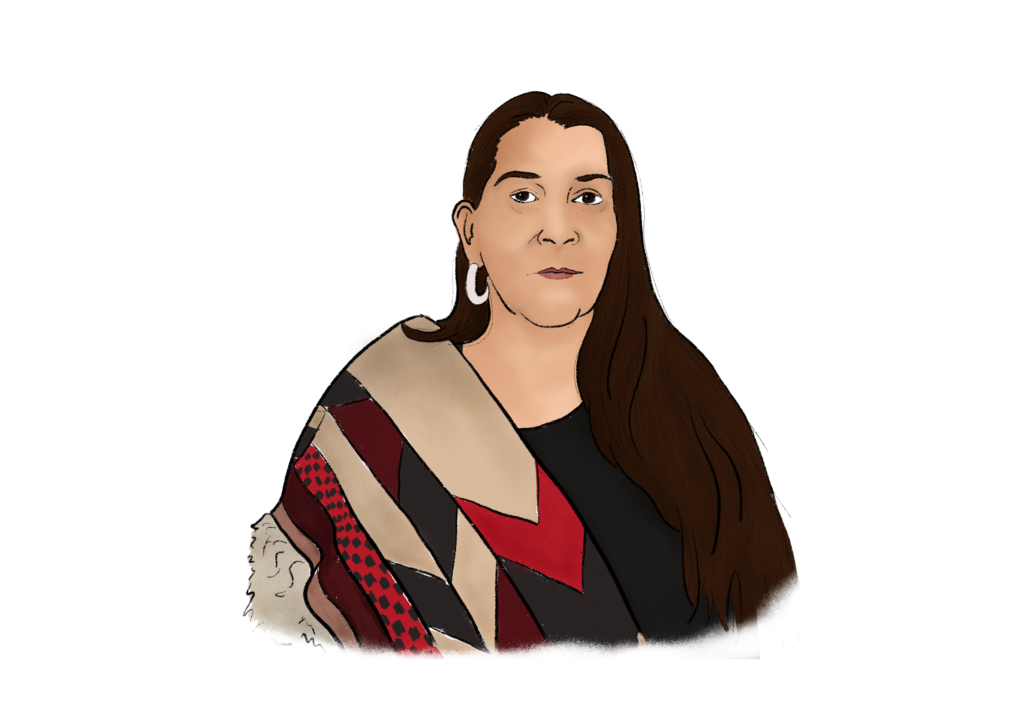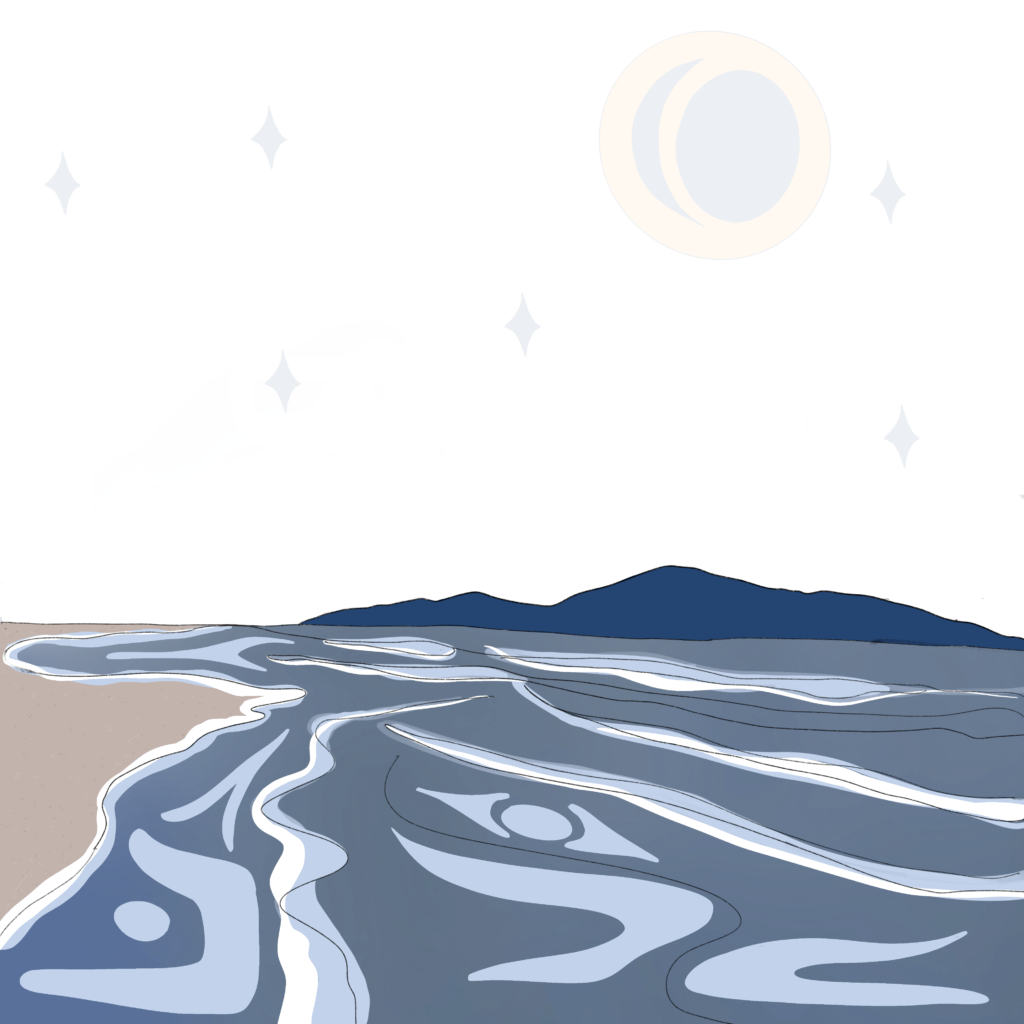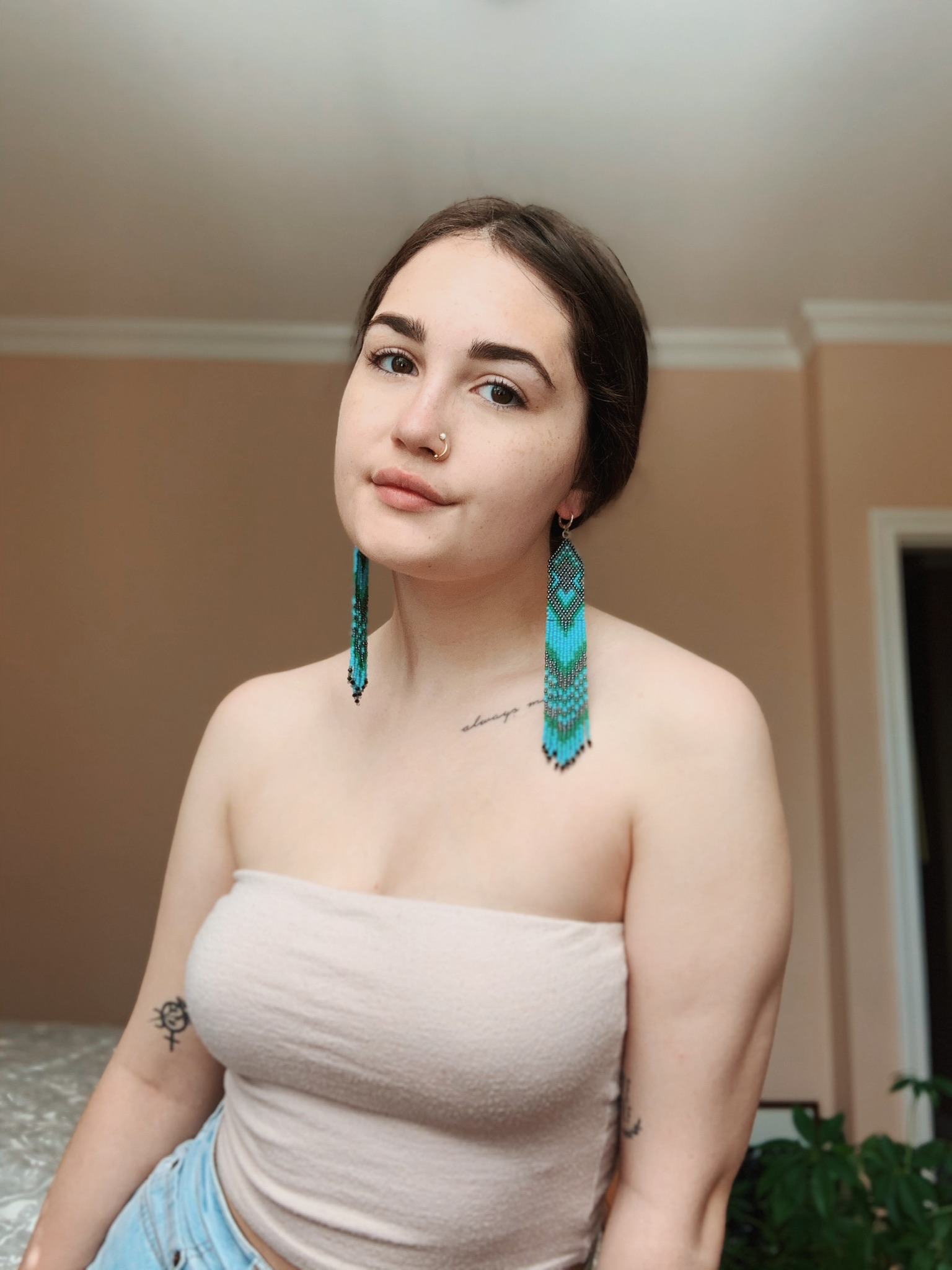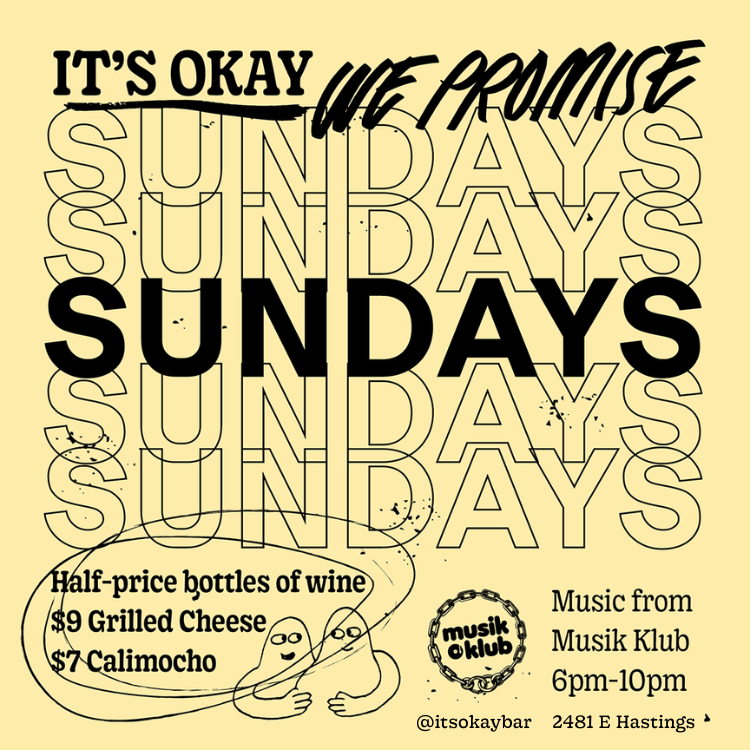(xʷməθkʷəy̓əm)
Cultural Advising by Nikki Sanchez-Hood, Decolonize Together
“Change some things, but not all things.”
As a prominent Musqueam Matriarch and Master Weaver, Debra Sparrow has relied on this quote from her grandfather as a guide while rebuilding cultural practices from the ground up. Her journey over the past 34 years has transformed “Vancouver” through both her captivating blankets and unrelenting spirit. Her passion for revitalizing Musqueam culture has led her to dream of wrapping the city in weaving, which we hope to see come true.
Did you know you wanted to be a weaver when you grew up?
My grandson asked me today, did you ever have anything in mind that you wanted it to be when you grew up?
And I said, actually, no, I didn’t have a goal. I didn’t say I want to grow up and be this or be that. All the work that I’m doing today was not part of our community because of residential school and colonialism. We were not weavers. We were not creators of holding what reflected us because of residential schools, Catholicism, and the Anglican churches stopping anything that reflected our history. So we saw little tiny bits here and there, but you know, not a lot.
I didn’t grow up with these beautiful visions that I’m creating now and I kind of wondered what was my part in the world.
I was fortunate enough to be inspired by the Northern people in the Alert Bay Area, who, even though there was a halt on our culture, went underground and they kept doing their culture. They kept dancing, singing when no one was around. So, I lived up there for five years and I really was in awe of them. And when I came back home to Musqueam I thought, well, what were we doing?
That’s where I started researching on my own—not at school or an institution, but by asking questions to my grandfather and family. There was this longing to know who I was more than I did. I had my ups and downs, like everyone else, I had my dark days. And in those dark days, I think instead of feeling sorry for myself, I kept using them to grow something, but I didn’t know what that was yet.
When we are in a really sad place and we don’t know what to do, I think it was there that I reached even deeper. And I asked, okay, universe, what do you want of me? What am I supposed to be doing? I know it kind of sounds romantic, but you know, I did it all the time. I kept asking, what should I do? What should I do? What should I be?
Then I started my healing process where I started reading a lot of books on healing and I knew that’s what I wanted. I wanted to let go of all the things that detoured me from who I was. So I put away all the things that were fun in my young life and became more serious.
I started studying Salish graphic design, and I say graphic design because that’s all we understand today, but it was actually all of the beautiful reflections of the people as they lived in this land pre-contact.

What is one thing you would like others to know about the Musqueam people?
I think really the most important thing is that we’re not here to threaten anybody. I think society is threatened when residential school reconciliation happened and then people are going, “Oh no, what are they going to do? What do they want?”
What we want is to be recognized in our own land, as people who have been here for thousands of years, people who welcomed all of the first people coming here, people who shared our land, not knowing what the future was going to bring us and how things were going to unfold. Because we had trust in the beginning, we had friendships in the beginning and then we turned our back and we got stabbed in the back. We got the rug pulled out from us.
Captain Vancouver and the Spanish ship that came in in 1791, the first thing they talked about were the beautiful blankets that everyone was wearing. They acknowledged them and they talked about them. Captain Vancouver said the women were as beautiful and as regal as his own. Wow. That’s the thing that I’m so honored to be a part of.
When I look at the complexity of life at that time these blankets are a part of our intelligence and integrity, because to be a weaver is about mathematics. It’s about science. When you’re dying and you’re out in the environment, you’re seeing what kind of colors you can get and what kind of medicines they can create. There is also social studies and history. It’s talking about your family. We have a responsibility to know our history and our names. Especially with Squamish and Tsleil-Waututh, we all know how we’re related. We know our ancestry. We don’t have to go on ancestry.com.
I actually had a friend who does genealogy and when I went on ancestry I talked about my grandfather, we could only go back to 1811 because prior to 1811, there was nothing documented here. But I could tell her verbatim when she went and found our roots, I already knew all the names. I already knew all of the things that she thought she was bringing to me. It’s oral history. So when she said them in English, I said them in our language. I can go further back in 1811 because of my grandfather.
What I also want Vancouver to know is that this work that we are venturing out to bring with us also reflects your history. Now in Vancouver, this is about all of us together here in this land and nobody’s going anywhere. That’s how I got involved with the Vancouver Mural Festival. I saw an advertisement for it and I actually emailed them and said, “Where’s Musqueam?” They emailed me back and we got together immediately and started talking and just having a conversation. So, I did my first mural with them under the Granville Street Bridge on a pillar.
I think one thing I want Vancouver to know to think about is that when you look at something that has a label on it that says Debra Sparrow, that you’re not just thinking of Debra Sparrow, you’re thinking of all of the people in Musqueam’s history.
I’m just a messenger through the work. We’re attracted to beauty. No matter whether we want to say we are not, we just are. As soon as you see something beautiful on the side of the road and you go, wow, what, what is that? It begins an education process. You want to know what it is, where it came from. And then you’re surprised and you go, “I didn’t know we had this in Vancouver. I didn’t know Musqueam, Squamish, and Tsleil-Waututh people had such beautiful work.”
There’s a lot of political negativity around who we were as people and no one’s voicing our intelligence. Sometimes we don’t have to speak it, we do it. A lot of times matriarchs were standing behind their men and they didn’t mind that because they had their voices and they would communicate with their men. So the men looked strong, but who was really strong was the women.
Women have always been equal in our cultures. When the men went hunting to provide food and the mountain goat and the hide was used for the blankets, everybody worked together, there was no individual. You wouldn’t survive. Everyone worked together in a group. Everybody shared, there was no homeless people.
How do you feel about stepping into the role of a matriarch?
In our communities, our villages, we always respected our elders. That’s part of our nature, part of our connection in society.
Somebody asked me lately what I thought of the word matriarch. And I said, it seems to be a go-to word these days. In our communities, we didn’t use words like that. Of course we didn’t have English terms for them, but you know, even being a woman of a certain age, there’s always women older and those are the ones I respect. Like they’re 80 and 90 and 70. And even in their sixties, I don’t think of myself as a matriarch.
I think of myself as someone who’s just moving through every stage of life and embracing it. I’m responsible to those women who stood in front of the loom pre-contact who taught their girls how to respect themselves, to prepare themselves for womanhood, to prepare themselves for marriage.
Sometimes these were young women because some of us get our first, what we call moons, when we’re 12, 15, or 16. When we do, we get prepared for marriage because we’re a woman, but today we’re like, “Oh my God, are you kidding?” [Young girls] don’t even know what they’re doing. We just send them to school where the tools are different. And if we dare try to focus on ways in which some cultures prepare their young ladies or men, we might get in trouble and say, don’t bring that to our classroom. And I understand that, but I think that what ceremony misses is that we kind of get off track. If you drive out to UBC along the beautiful drive, way up on the bluff of these beautiful homes and mansions you see where our mansions used to be—longhouses.
And my grandfather pointed and he said, “Do you see that house over there? There used to be a longhouse there and it was only for young women who are getting their first monthly periods to go with the other women.” They would stay there and prepare—prepare their life, prepare their teachings. And I was like, wow, like if he wasn’t with me on that drive, I would’ve never known that. We would’ve missed that conversation.
I was really honored to have him until he was a hundred. He was my teacher, my mentor, but mostly we talked just about the land. We talked about what he remembered, how he helped sometimes making his way to the city of Vancouver and helped log the roads. He was a fisherman, he was a political man. He was a chief, he was a caretaker. He loved to garden. He loved his history and he passed that to me. I think that’s why we were so close because I was thirsty for the knowledge that he passed me.
I wanted him to be my professor, not somebody out at UBC. If you look around the world, now we are all becoming the same. We all want to go to school. We go to certain universities and they all guide us in one direction. I always like to say, I want to go to the school of life. You know, I want to experience things. I want to learn from other people. I never was one to get an education that way.
What is one thing that makes you feel empowered as a Matriarch? Who do you turn to for community care?
I don’t really turn to anyone. I’m very secure in my connection with the blankets that I make. They are not just a blanket—they’re my healing, my medicine. They enable me to pay attention to the depths of who we are. Not only as a human, but a spirit and allowing that secure connection to come to you as part of the universe and the environment.
I never really turn to anybody. I turn to what do we want to say, God, Allah, you know, the universe. I rely on that more than I rely on humans because I realized that humans have a big ego and they’re very small centers, except for a few that I share deep connections with.
In sharing, I realized that we are a communal family in Musqueam. We too have lost our way a bit and we’ve become individual families. We come together when we have things happen in our community, whether it’s a wedding, a funeral, a naming ceremony, or whatever we are doing, we come together, even if there are unresolved issues in some families. We realize we have to put that aside and we know how to do that because our elders taught us that when you come into a place where people gather, you leave all the negative outside the door.
My work is connected to my heritage, to my lineage, it’s connected to me. It’s given me strength through paying attention. Every time I do a stitch, every time I make a blanket for a Chief, for a ceremony, I am honored and I stand on that and that’s integrity. That gives me strength to just carry on and keep sharing those gifts. Everyone has gifts and we just have to keep giving those gifts out, if we shared them again, we wouldn’t be in the state that we are in.
The world is going by so fast and they’re on such a fast track. I don’t know where they’re going. And I always say, I don’t know if I’d want to go. Where are you going, Vancouver? Who are you Vancouver? What is your identity? But I do trust that amongst all the people, there is a level of such intelligence and amazing people who are doctors and scientists and others.

You are also a Master Weaver. Can you talk a bit about teaching others?
I don’t teach the way people are used to being taught in schools. It’s all oral and step-by-step. I like to say that I guide people. I don’t teach them because I feel like everyone has a different way of learning and I love that. I allow them to learn the way they feel like they want to. So if I show them a few steps and then something happens and they ask me, “Is that right?” I’ll ask them, “Do you think it is, is it right?” You know, like, I want them to draw that conclusion. Eventually they’ll figure it out and that empowers you.
It is easier for people to learn now because no one taught us. We didn’t have teachers. We had to figure things out. We relied on our instincts. We had to be deeply attached to our ancestors and our women who we asked to come be with us and guide us. They guided us. Now we guide other women and men who want to learn.
My grandson’s fifteen and he made one for school and did a fabulous job, which I was very surprised by because he’s a young fellow.
I didn’t think he would want to be a weaver and I jumped to conclusions, so I was really taken to sit with him and watch him every hour that he worked. And I asked him as a young man, I said, “So, what do you think of this?” He goes, “Well, I really love doing this.” And I said, “It’s really interesting that you would like it because really it was done by mostly women before contact.” And this fellow, he caught on right away. And he said, oh, I love it. He said, “Oh, I love it! I would even like to make clothes maybe.” And I said, “Well, yes, they’re textiles.” That’s how all the people in the world dressed themselves, no matter what environment they were in, they drew on the fibers of their environment.
There’d be stinging nettle and mountain goat wool. There’s different mosses and plants that we use for dying and creating these beautiful blankets that reflect families or cultures. It wraps us continually in the love of who we are. And if it does that for my community, then I’m thinking that that’s the same for all communities all over the world, that blankets are just so important to all of us. So bringing them back into this community, into all the communities in Vancouver, it’s been a 34-year journey for me.
Even though I was alone, I was with all those people and ancestors who were with me inspiring me to keep going and keep moving and keep putting the message out there. Keep showing these people, keep showing your own people, keep doing it so it becomes a part of who we are again, and it is. And then to move through it and say, now that I come to this, I need to see where can I go? Now, I’m going out of my comfort zone and we’re creating a new way. And I said, “I don’t think I’ll ever stop weaving until I wrap the city of Vancouver.”
And while lo and behold, you know, 20 years later, five years later, it’s happening. And so not only is it going up on murals, it’s going up on buildings and schools and it’s making its way and weaving its way through the city. It’s there for all of you. It’s there for all of us to take a step back and reevaluate who we are as Vancouver. We share this with you. The beauty of Vancouver will have something to be proud of when they talk about their environment now that this reflects that history.
As said in an interview with Sue Rowley, “When we look inward we find information that isn’t written in a book.” How does this concept guide your work as a matriarch?
Well, go to my work even before I was a matriarch, it is who I am. It is what we were immersed in as we grew up as children here in Musqueam, in our traditional territory, all throughout Vancouver. We really were secure here. We have evidence 3000 years in this particular village, 9000 years in Jericho, thousands of years in Spanish banks Locarno, Kitsilano, Stanley Park, up the inlet—you’ll hear from the other women.
So, you know, this kind of conversation that I have with very many Vancouverites now is not just as someone my age. I didn’t really understand it when I was younger, but I love having this conversation now with young people because I think you are all so especially aware.
What would you like others to know about the designs and intricacy of weaving patterns?
If you look at the designs on the patterns, people were really embracing all of this and keeping in touch with their environment, whether it was the water, sky, the trees, the earth, whatever. We were always connected to reflecting how we saw our visions of how we respected our environment. Today, I feel kind of bad that people live in cement buildings, that we live on concrete floors.
How are we supposed to be inspired? We’re trapped in mental health. We’re trapped in there because that’s what society does to us. So to untrap ourselves we have to believe that we have more than just what’s up here. We have to go to what’s in the middle of our heart and soul, and it’s connected to living beings—whether it’s the forest, the earth, the water. Go out and go for a walk, but we don’t do that because we’re so used to just being in the city and our homes feeling trapped.
How are you continuing to thrive as a Coast Salish people with a major metropolitan city on your land?
We have to accommodate to live in this world and we’ve kind of been watching the world go by. I always ask people, “How is the concrete jungle working for you?” Because when I step into the city I don’t feel warmth and that has sparked a lot of ideas about wrapping the city. You see cultures around the world have their artists and creative people bring warmth into concrete landscapes and I wanted to do the same in Vancouver.
What are your feelings on colonial impositions of land and resource extraction?
I don’t need anything out there. I’m quite happy to have the most simplest things, but the world wants it all and all of those things add to the destruction as well.
So, we’re destroying ourselves and I just don’t know where to go with it. I’m sad. To us, everything is sacred, everything comes back to relationships. I think that’s partly why I feel my job is that I’m putting up these beautiful patterns that reflect our world, so can we remember that this is here too, because you know, no one seems to really worry. They say they want a job, but when they cut all the trees down, they’re not going to have a job. And when they suck all the oil out of the earth, you’re not going to have a job. And when they, when they poison all the water, they’re not gonna have anything to drink.
What does money mean when having a home and a beautiful earth is gone?
What is your vision for Musqueam Nation ten years from now?
Looking into the future, I believe in the youth. I believe in my grandsons.




